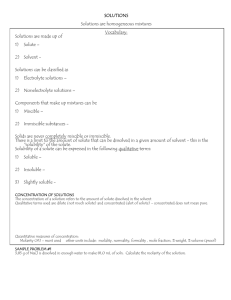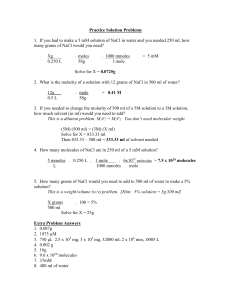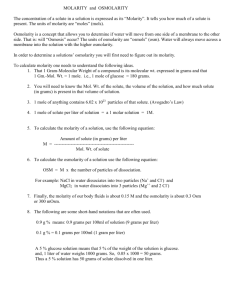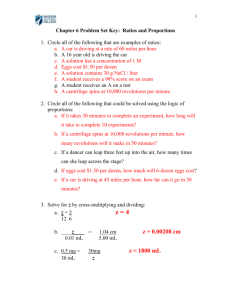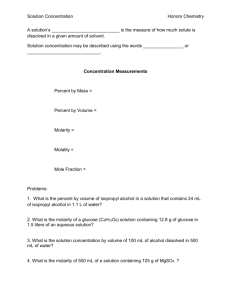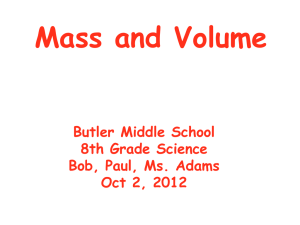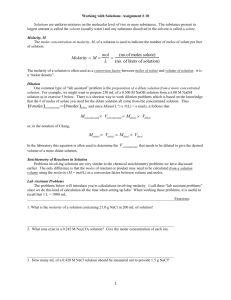Solution Concentration Worksheet: Chemistry Problems
advertisement
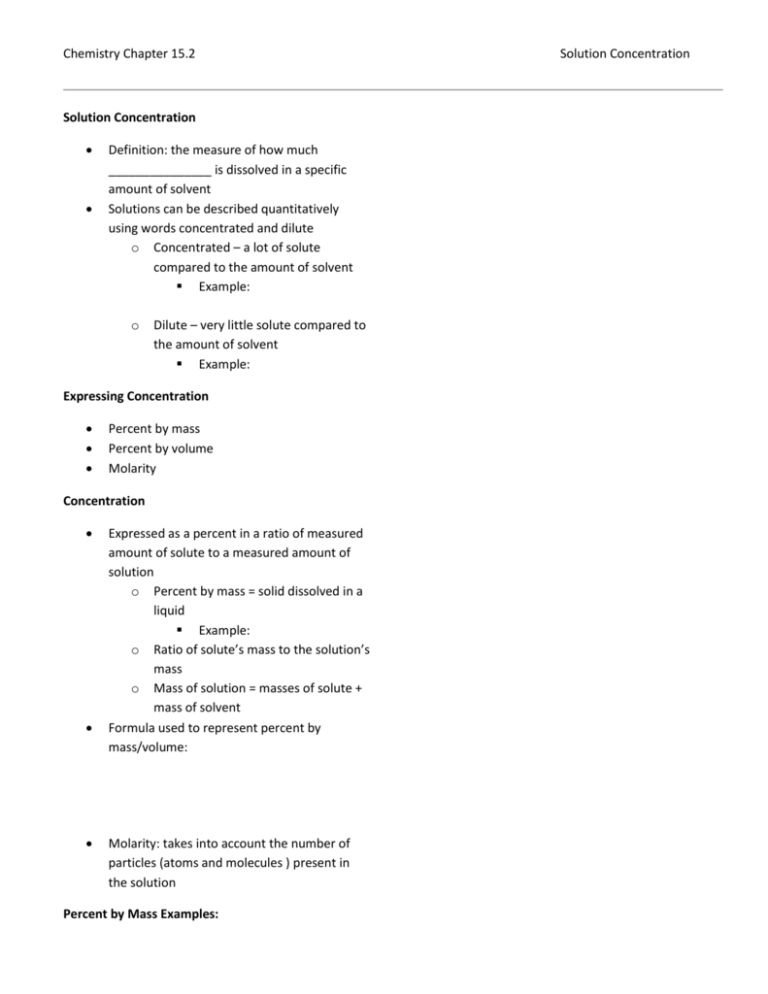
Chemistry Chapter 15.2 Solution Concentration Definition: the measure of how much _______________ is dissolved in a specific amount of solvent Solutions can be described quantitatively using words concentrated and dilute o Concentrated – a lot of solute compared to the amount of solvent Example: o Dilute – very little solute compared to the amount of solvent Example: Expressing Concentration Percent by mass Percent by volume Molarity Concentration Expressed as a percent in a ratio of measured amount of solute to a measured amount of solution o Percent by mass = solid dissolved in a liquid Example: o Ratio of solute’s mass to the solution’s mass o Mass of solution = masses of solute + mass of solvent Formula used to represent percent by mass/volume: Molarity: takes into account the number of particles (atoms and molecules ) present in the solution Percent by Mass Examples: Solution Concentration Solution Concentration Practice I 1. What is the % concentration by mass of 8.3 g of NaCl dissolved in 300 g of water? (2.7%) 2. What is the % concentration by mass of 65 g of C6H12O6 dissolved in 500 g of water? (11.5%) 3. You have a 1000 g bleach solution. The % concentration by mass of the solute NaOCl is 6.02 % . How many grams of the NaOCl are in the solution? (60.2 g) 4. How many grams of water would you have to add to 50 g of NaCl to produce a solution concentration of 5%? (950 g) 5. What is the solution concentration by mass of 12 grams of NaCl dissolved in 300 grams of water? (3.8%) 6. If you need to produce 500 grams of an 8.3% saline solution, how many grams of salt and how many grams of water would you use to form the solution? (41.5 g of salt, 458.5 g H2O) Percent by Volume Examples: 1. What is the percent by volume of ethanol in a solution that contains 35 mL of ethanol dissolved in 115 mL of water? 2. If you have 100 mL of a 30% aqueous solution of ethanol, what volumes of ethanol and water are in the solution? 3. What is the percent by volume of isopropyl alcohol in a solution that contains 24 mL of isopropyl alcohol in 1.1 L of water? 4. What is the percent by volume of 140 mL of isopropyl alcohol dissolved in 60 mL of water? 23.3%, 30 mL/70 mL, 2.1%, 70% Dilution Solutions Concentrated stock solutions of chemicals are purchased in the laboratory because they are much more economical to buy These solutions are diluted to desired concentrations that are required by the labs we perform in class To properly dilute solutions we use the following equation: o o Where ‘M’ = Where ‘V’ = Diluting Solutions Examples: 5. What volume of a 3M KI solution would you use to make .3 L of a 1.25M KI solution? 6. How many milliliters of a 5M H2SO4 solution would you need to prepare 100 mL of .25 M H2SO4? 7. If you dilute 20 mL of a 3.5M solution to make 100 mL of solution, what is the molarity of the dilute solution? 125 mL, 5 mL, .7M Molarity When chemists are working with a reaction in an aqueous solution, they must know the number of particles (atoms, molecules) that are present Since we count the number of particles present using moles, then the number of moles of solute dissolved per liter of solution is referred to as ____________ (M), or molar concentration The unit ‘M’ is read as molar A liter of solution containing one mole of solute is read as a 1 Molar Solution The following formula is used to calculate the molarity of a solution: Molarity Practice I 1) 58 g NaCl 1 Liter 1 molar 2) ____ g NaCl 1 Liter 2 molar (116 g) 3) 58 g NaCl .5 Liter ________ (2 M) 4) ____ g NaCl 5) 232 g NaCl 1 Liter 1 Liter .5 Molar __________ (4 M) 6) _____g LiCl 1 Liter 7) 200 g CaCO3 1 Liter ___________ (2 M) 8) 98 g CCl4 1 Liter ____________ (.64 M) 9) 27 g CaCO3 500 mL ____________ (.54 M) 10) _____g CaSO4 1 Liter 2 Molar (29 g) 2.3 Molar (84 g) (312.8 g) 11) _____g NaCl 350 mL .8 Molar (16.24 g) 12) 87 g LiCl _______ 1 molar (2.07 L) 13) ______ g C6H12O6 800 mL 1.5 molar ( 216 g) 14) 58 g H2SO4 300 mL ________ (1.97 M) 15) 128 g CO2 _______ 3.2 M 16)______g NaSO4 1.8 L 2.7 M (578.3 g) 17) 12.6 g KCl 5.4 L ______ ( .03 M) 18) 172 g NaHCO 19) _____ g NaCl ____________ 1.7 M (.9 L) (1.95 L) 2.7 L 4.2 M (657.7 g) 20) 43 g HCl 225 mL _______ (5.3 M) 21) 183 g K2SO4 ________ 3.6 M (.29 L) This is a typical molarity problem: 1. What is the molarity of a solution containing 58 grams of salt in 1 Liter of solution? 2. What is the molarity of a glucose solution containing 12.8 g of glucose in 1.5 liters of an aqueous solution? 3. Calculate the molarity of 100 mL of a solution containing 50 g of H 2SO4. 4. What is the molarity of 500 mL of a solution containing 125 g of MgSO 4? 5. What is the solution concentration of 45 g of NaCl in 350 mL of water? 6. How many grams of salt would be dissolved in 1.0 L of a 0.5M solution of NaCl? 7. If the solubility of O2 is 8.3 g/L at 3 atm, how many g/L will dissolve at 10 atm? 8. How many grams of CaCO3 are contained in one liter of a 4M CaCO3 solution? 9. How many grams of Na3PO4 should be dissolved in 800 mL of water to make a .3M solution of Na 3PO4? 10. How many grams of LiCl are in 750 mL of a 4.0M LiCl solution? 11. If the solubility of N2 is 2.3 g/L at 3 psi, how much pressure is needed to dissolve 8.0 g/L? 12. How many grams of water must be added to 12 grams of salt to make a 15% solution concentration? 13. How many grams of C6H12O6 are needed to make a 600 mL of .3M aqueous solution of C 6H12O6? 14. How many grams of CCl4 are in 300 mL of a 5M CCl4 solution? 15. How many grams of NH3 can be produced with 500 g of N2 and an unlimited amount of H2?

